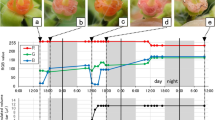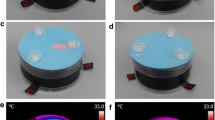Abstract
Many angiosperms have arranged their flowers in inflorescences forming a distinct signalling unit to flower visitors. In some species, the flowers of inflorescences undergo a temporal colour change corresponding exactly to a change in the reward status. Based on information obtained from the spectral reflection curves of pre-change and postchage colours of flower corollas and/or floral guides, it was possible to demonstrate that the colour phase associated with reward closely corresponds to the visual stimuli which trigger behavioural responses of inexperienced flower visitors, and that the colour phase associated with less reward corresponds to visual stimuli less attractive to naïve flower visitors. Reciprocal colour changes were not observed. It is to be assumed that the unidirectionality of floral colour changes is an adaptation of angiosperms aimed at the guidance of first-time flower visitors. Signalling reward to inexperienced flower visitors is an additional function of floral colour changes. The main function of floral colour changes, however, is to provide cues with which the flower visitors can learn to associate one colour phase with reward.
Similar content being viewed by others
References
Backhaus, W., 1991: Color opponent coding in the visual system of the honeybee. — Vision Res.31: 1381–1397.
—, 1993: Color vision and color choice behavior of the honey bee. — Apidologie24: 309–331.
—, 1987: Color distance derived from a receptor model of color vision in the honeybee. — Biol. Cybernetics55: 321–331.
Biedinger, N., Barthlott, W., 1993: Untersuchungen zur Ultraviolettreflexion von Angiospermenblüten I.Monocotyledonae. — Trop. Subtrop. Pflanzenwelt86: 1–122.
Bishop, L. G., 1974: An ultraviolet photoreceptor in an dipteran compound eye. — J. Comp. Physiol.91: 267–275.
Burr, B., Barthlott, W., 1993: Untersuchungen zur Ultraviolettreflexion von Angiospermenblüten II.Magnoliidae, Ranunculidae, Hamamelididae, Caryophyllidae, Rosidae. — Trop. Subtrop. Pflanzenwelt87: 1–193.
—, 1995: Untersuchungen zur Ultraviolettreflexion von Angiospermenblüten III.Dilleniidae undAsteridae. — Trop. Subtrop. Pflanzenwelt93: 1–185.
Burkhardt, D., 1983: Wavelength perception and colour vision. — InCosens, D. J., Vince-Price, D., (Eds): Society for Experimental Biology Symposium XXXVI “The biology of photoreception”, pp. 371–397. — Cambridge: Cambridge University Press.
Caspar, B. B., La Pine, T. R., 1984: Changes in corolla color and other floral characteristics inCryptantha humilis (Boraginaceae): cues to discourage pollinators? — Evolution38: 128–141.
Chittka, L., 1992: The colour hexagon: a chromaticity diagram based on photoreceptor excitations as a generalized representation of colour opponency. — J. Comp. Physiol. A170: 533–543.
—, 1992: Color coding and innate preferences for flower color patterns in bumblebees. — InElsner, N., Richter, D. W., (Eds): Proceedings of the 20th Göttingen Neurobiology Conference, p. 298. — Stuttgart: Thieme.
—, 1992: The evolutionary adaptation of flower colors and the insect pollinator's color vision. — J. Comp. Physiol. A171: 171–181.
—, 1992: Opponent coding is a universal strategy to evaluate the photoreceptor inputs inHymenoptera. — J. Comp. Physiol. A170: 545–563.
—, 1994: Ultraviolet as a component of flower reflections, and the colour perception ofHymenoptera. — Vision Res.34: 1489–1508.
Daumer, K., 1958: Blumenfarben, wie sie die Bienen sehen. — Z. vergleichende Physiol.41: 49–110.
Delph, L. F., Lively, C. M., 1985: Pollinator visits to floral colour phases ofFuchsia excorticata. — New Zealand J. Zool.12: 599–603.
Giurfa, M., Nuñez, J., Chittka.L., Menzel, R., 1995: Colour preferences of flower-naive honeybees. — J. Comp. Physiol. A177: 247–259.
Goldsmith, T. H., 1990: Optimization, constraint, and history in the evolution of eyes. — Quart. Rev. Biol.65: 281–322.
—, 1979: Discrimination of colors by the black-chinned hummingbird,Archilochus alexandri. — J. Comp. Physiol.130: 209–220.
Gori, D. F., 1989: Floral colour change inLupinus argenteus (Fabaceae): Why should plants advertise the location of unrewarding flowers to pollinators? — Evolution43: 870–881.
Höglund, G., Hamdorf, K., Rosner, G., 1973: Trichromatic visual system in an insect and its sensitivity control by blue light. — J. Comp. Physiol.86: 265–279.
Ilse, D., 1949: Colour discrimination in the dronefly,Eristalis tenax. — Nature163: 255–256.
Jokl, S., Fürnkranz, D., 1989: Antheseabhängige UV-Muster in Blütenständen von Asteraceen. — Pl. Syst. Evol.165: 91–94.
Knoll, F., 1925: Lichtsinn und Blütenbesuch des Falters vonDeilephila livicornica. — Z. vergleichende Physiol.2: 329–380.
—, 1927: Über Abendschwärmer und Schwärmerblumen. — Ber. Deutsch. Bot. Ges.45: 510–518.
—, 1956: Die Biologie der Blüte. — Berlin: Springer.
Kostka, G., 1922: Farbenwechsel und Insektenbesuch beiPulmonaria officinalis L. — Österr. Bot. Z.71: 246–254.
Kruijer, J. D., 1987: The ecological function of the retention of withered, non-rewarding flowers ofEchium plantagineum. — Acta Bot. Neerl.36: 139–140.
Kugler, H., 1936: Die Ausnutzung der Saftmalsumfärbung bei den Roßkastanienblüten durch Bienen und Hummeln. — Ber. Deutsch. Bot. Ges.54: 394–399.
—, 1950: Der Blütenbesuch der Schlammfliege (Eristalomyia tenax). — Z. vergleichende Physiol.32: 328–347.
—, 1963: UV-Musterungen auf Blüten und ihr Zustandekommen. — Planta59: 296–329.
—, 1966: UV-Male auf Blüten. — Ber. Deutsch. Bot. Ges.79: 57–70.
—, 1970: Blütenökologie. — Stuttgart: Fischer.
Lamont, B., 1985: The significance of flower colour change in eight co-occurring shrub species. — Bot. J. Linn. Soc.90: 145–155.
Laughlin, S. B., 1981: Neural principles in the peripheral visual system of invertebrates. — InAutrum, H., (Ed.): Invertebrate visual centers and behaviour. — Handbook of sensory physiology,VII/6b, pp. 133–280. — Berlin, Heidelberg, New York: Springer.
Lex, T., 1954: Duftmale an Blüten. — Z. vergleichende Physiol.36: 212–234.
Lunau, K., 1988: Innate and learned behaviour of flower-visiting hoverflies. — Flowerdummy experiments withEristalis pertinax (Scopoli) (Diptera, Syrphidae). — Zool. Jahrb. Physiol.92: 487–499.
—, 1990: Colour saturation triggers innate reactions to flower signals: flower dummy experiments with bumble bees. — J. Comp. Physiol. A166: 827–834.
—, 1992a: Limits of colour learning in a flower-visiting hoverfly,Eristalis tenax L. (Syrphidae, Diptera). — Eur. J. Neurosci., Suppl.5: 103.
—, 1992b: Innate flower recognition in bumble bees: orientation of antennae to visual stamen signals. — Canad. J. Zool.70: 2139–2144.
—, 1993: Interspecific diversity and uniformity of flower colour patterns as cues for learned discrimination and innate detection of flowers. — Experientia49: 1002–1010.
—, 1995: Notes on the colour of pollen. — Pl. Syst. Evol.198: 231–248.
—, 1995: Innate colour preferences of flower visitors. — J. Comp. Physiol. A177: 1–19.
—, 1994: Visual key stimuli of the innate proboscis extension in the hoverflyEristalis tenax L. (Syrphidae, Diptera). — J. Comp. Physiol. A174: 574–579.
—, —, 1995: Wavelength-specific behaviour in the innate proboscis extension of the hoverflyEristalis tenax. — InElsner, N., Menzel, M., (Eds): Proceedings of the 23th Göttingen Neurobiology Conference, p. 376. — Stuttgart: Thieme.
- -Chittka, L., 1996: Colour choices of naive bumble bees and their implications for colour perception. — J. Comp. Physiol. A (in press).
Macior, L. W., 1964: An experimental study of the floral ecology ofDodecatheon meadia. — Amer. J. Bot.51: 96–108.
Menzel, R., 1967: Untersuchungen zum Erlernen von Spektralfarben durch die Honigbiene (Apis mellifica). — Z. vergleichende Physiol.56: 22–62.
—, 1979: Spectral sensitivity and color vision in invertebrates. — InAutrum, H., (Ed.): Comparative physiology and evolution of vision in invertebrates. — Handbook of sensory physiologyVII/6 a, pp. 503–580. — Berlin, Heidelberg, New York: Springer.
—, 1985: Learning in honeybees in an ecological and behavioral context. — Fortschr. Zool.31: 55–74.
—, 1993: The ecology of flower colours and the natural colour vision of insect pollinators: the Israeli flora as a study case. — Biol. Rev.68: 81–120.
Moelino, B. M., 1987: Changing of UV-patterns of flowers ofEchium plantagineum during senescence. — Acta Bot. Neerl.36: 139.
Osche, G., 1983: Optische Signale in der Coevolution von Pflanze und Tier. — Ber. Deutsch. Bot. Ges.96: 1–27.
Peitsch, D., Fietz, A., Hertel, H., de Souza, J., Fix Ventura, D., Menzel, R., 1992: The spectral input system of hymenopteran insects and their receptor-based colour vision. — J. Comp. Physiol. A170: 23–40.
Schemske, D. W., 1976: Pollinator specificity inLantana camara andL. trifolia (Verbenaceae). — Biotropica8: 260–264.
Scherer, C., Kolb, G., 1987: Behavioral experiments on the visual processing of color stimuli inPieris brassicae L. (Lepidoptera). — J. Comp. Physiol. A160: 645–656.
Steiner, A., Paul, R., Gemperlein, R., 1987: Retinal receptortypes inAglais urticae andPieris brassicae (Lepidoptera) revealed by analysis of the electroretinogram obtained with Fourier interferometric stimulation (FIS). — J. Comp. Physiol. A160: 247–258.
Tsukahara, Y., Horridge, G. A., 1977a: Visual pigment spectra from sensitivity measurements after chromatic adaptation of single dronefly retinula cells. — J. Comp. Physiol.114: 233–251.
—, —, 1977b: Interaction between two retinula cell types in the anterior eye of the droneflyEristalis. — J. Comp. Physiol.115: 287–298.
Vogel, S., 1950: Farbwechsel und Zeichnungsmuster bei Blüten. — Österr. Bot. Z.97: 44–100.
—, 1954: Blütenbiologische Typen als Elemente der Sippengliederung. — InTroll, W., Guttenberg, H., (Eds): Botanische Studien. — Jena: G. Fischer.
Wacht, S., Lunau, K., 1995: Photoreceptor interactions in the innate proboscis extension in the hoverflyEristalis tenax as revealed by behavioural tests under selective chromatic adaptation. — InElsner, N., Menzel, M. (Eds): Proceedings of the 23th Göttingen Neurobiology Conference, p. 377. — Stuttgart: Thieme.
Waser, N. M., 1986: Flower constancy: definition, cause, and measurement. — Amer. Naturalist127: 593–603.
—, 1979: Effective mutualism between sequentially flowering plant species. — Nature181: 670–672.
Weiss, M. R., 1991a: Floral colour changes as cues for pollinators. — Acta Hort.288: 294–298.
—, 1991b: Floral color changes as cues for pollinators. — Nature354: 227–229.
Zander, E., 1921: Das Leben der Biene. Handbuch der Bienenkunde IV. — Stuttgart: Ulmer.
Author information
Authors and Affiliations
Rights and permissions
About this article
Cite this article
Lunau, K. Unidirectionality of floral colour changes. Pl Syst Evol 200, 125–140 (1996). https://doi.org/10.1007/BF00984753
Received:
Revised:
Accepted:
Issue Date:
DOI: https://doi.org/10.1007/BF00984753




